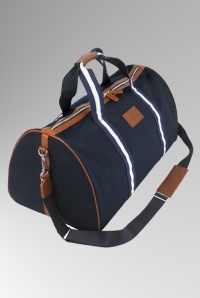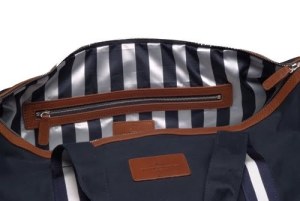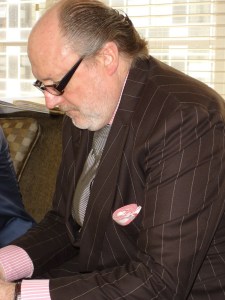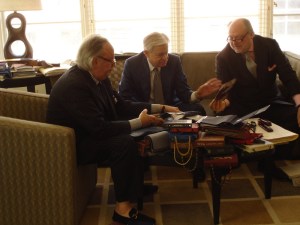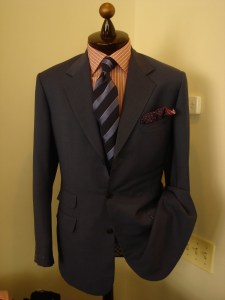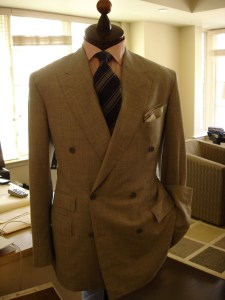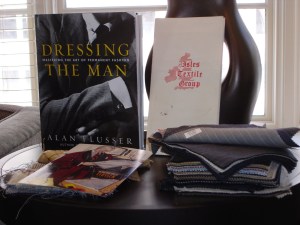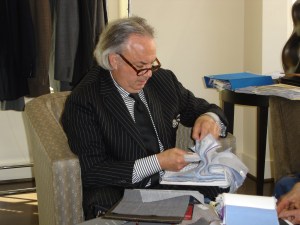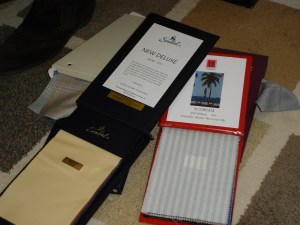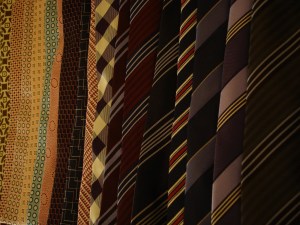Ivy League Via London
If you are trying to track down that perfect Yalie bag, it might be worth looking to the Brits for inspiration.
Smart Turnout’s new Yale University Canvas Holdall has a beefy exterior belying a clever blue and white striped silk lining.
While I have not gotten my hands on one yet, Smart Turnout is a longtime friend of OTC and we’re pretty sure this bag has the stuff we like. Thick canvas, sturdy leather trim and heavy zippers add substance to its preppy functional coolness.
It looks to be about the right size for an overnight trip up to Boston for The Game or lugging provisions to your buddy’s tailgate shindig. Once you’ve sufficiently beaten it up, I bet this bag would even be a nice Friday office bag.
Start ‘Em Early
Add in some Dogfish Head 90 Minute, and it was a nice time indeed.
I never looked that good at his age.
The Spring/Summer Scarf
 So, is the summer scarf fashion or fad?
So, is the summer scarf fashion or fad?
I’ll try a third option and let’s call it stylish. When I first noticed the trend of men sporting gauzy, lightweight scarves last year, my initial reaction was something to the effect of, “oh, please…”
If it’s warm outside that automatically makes the use of any kind of scarf that of a fashion accessory. And that, my friends, is a recipe for manly disaster.
Except that I’ve actually tried it out and, well, I kind of like it.
When it comes to styles that appear even slightly effeminate, like lightweight scarves in warm weather, American men tend to reflexively run the other way. European guys seem to make such accessories look annoyingly cool and natural.
Though not implying that I hang out at chic street cafes and tool around DC in an Aston Martin Vanquish, I do indeed have two summer scarves, both from Drakes-London, one of the forces promoting this look.
Since Drakes had actually given me my scarves for free I felt an obligation to man up and try them out, and so I did. While obviously impractical for high summer – though lightweight they really do retain heat quite well – for a cool or breezy evening, they are very nice.
And let me just point out that if Michael Drake thinks summer scarves are cool, manly and totally masculine, you best reconsider your opposition. Most of the brand names you encounter on an average trip to your clothier of choice think Michael is about the most stylish guy to tie a tie.
The two scarves pictured in this post, currently available at Drakes-London, are particularly classic, versatile and compatible.
Worn lightly wrapped around the neck or folded and looped in a European fashion, the summer scarf takes on the look of something picked up in Marrakesh or Paris. It has a certain exotic feel to it that is more world traveler than fashion victim.
That said, this kind of nonchalant elegance is a delicate balance. Summer scarves need to have a rich but muted coloring to them, and a classic but unfussy pattern; masculine yet relaxed and un-stuffy. Drakes’ scarves in particular are feather light, extremely malleable and made from some exceptional fabrics.

Washed Linen Blend Madras
Another point, and frankly this is more important, is to not care what anyone else thinks. This is a leap of faith for a lot of men and ultimately if it’s not for you then don’t wear it. It’s a personal look that comes nowhere near American Ivy League, but it is nonetheless a classic, classy look. My wife actually likes the look and, frankly, that surprised me.
But when paired with a light sport coat or blazer it can feel quite natural. In my case, with worn-in khakis and a white oxford, my outfit had that nice thrown together, been-around-the-world look to it.
Brand Repositioning Done Right: Smart Turnout
 How do you reposition a brand that’s already successful in your home market for customers across the ocean? Take a page from the playbook of British apparel and accessories retailer Smart Turnout.
How do you reposition a brand that’s already successful in your home market for customers across the ocean? Take a page from the playbook of British apparel and accessories retailer Smart Turnout.
OTC has long been an admirer of this creative and authentically English brand. Originally built around jumpers (sweaters to us Americans) executed in British regimental colors, The Smart Turnout brand moved on to outstanding enameled cuff links and regimental ties.
Initially, the company continued with the regimental themes but branched out a bit and produced some American Ivy League inspired ties and cuff links. Throw in some very popular nylon canvas watchstraps and Smart Turnout was on a roll.

But rolling where? The brand was expanding at a very healthy pace in its home market but founder Philip Turner had bigger ideas and wanted to capture the American Market as well. How do you re-brand a distinctly British company for American consumption while offering primarily British/inspired products?
Take a look HERE and find out.
The approach? Reestablish Smart Turnout as a sleeker “city” brand without totally abandoning its “country lifestyle” roots. Build up the brand’s storyline by creating an overall brand narrative woven throughout the paper catalog and recently relaunched website (a great one by the way).

Smart Turnout’s new look
The result? Increased sales, better name and brand recognition and deeper American market penetration. This strategy also helped to build stronger association with Smart Turnout’s British heritage via the new “London” tag line in its name that, paradoxically, helps to establish brand value and exclusivity here in the States.

Overall, a great job of holding on to the core values, quality and uniqueness that made the brand initially successful while thoroughly modernizing everything about it. I think the best compliment is one noted by an OTC reader who told me that he could tell the whole brand had been refreshed and rebuilt, but he could not really pinpoint what was different – it just looked better.
Kennedy’s Officially Launches in Rockville – Tomorrow Night
 Kennedy’s All-American Barber Club, the upscale barbershop franchise I recently profiled, will be hosting it’s Rockville, Maryland, Grand Opening and Open House tomorrow, Wednesday, April 14th from 5:00 to 7:00 p.m.
Kennedy’s All-American Barber Club, the upscale barbershop franchise I recently profiled, will be hosting it’s Rockville, Maryland, Grand Opening and Open House tomorrow, Wednesday, April 14th from 5:00 to 7:00 p.m.
The evening’s proceeds will go to benefit the Wounded Warriors Project.
It’s going to be a lot of fun; food and beverages will be provided, along with grooming services and tours of the newest Kennedy’s Club located at 110 North Washington Street near the Rockville Town Square (free parking is located at the rear of the building). I plan to swing by myself. Read more about the company here.

Rockville Town Square
Attendees will be able to purchase signature haircut certificates for $25 each and signature haircut and shave certificates for $60 each, with the total proceeds going to support the Wounded Warriors Project.
Kennedy’s CEO, Chris Hurn, said, “We’re excited to launch our first barber club in the Washington, D.C. metro area, while we raise some money for this very worthy cause. Kennedy’s is a patriotic concept, and we’ve always supported veterans’ causes. We’ll continue to partner with similar worthy causes as we get the word out in new markets about our exciting concept.”
An Afternoon With Alan Flusser
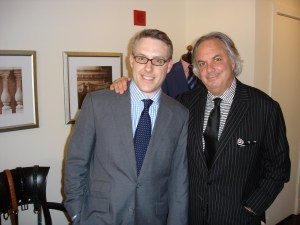 If there is one name in the world of menswear that genuinely deserves the overwrought moniker of legend, it’s Alan Flusser.
If there is one name in the world of menswear that genuinely deserves the overwrought moniker of legend, it’s Alan Flusser.
Alan is not just a menswear designer, not just an author, not just an innovator and not just the guy who invented Gordon Gekko’s signature look for the movie Wall Street (only one of several movies for which he worked his magic). He is also one of the most well-versed and well-read menswear experts alive today. Flusser is such a close friend of Ralph Lauren, that Lauren asked him to write his biography, which he’s currently working on. He’s also a very nice guy.
Alan Flusser literally wrote the book on dressing well; more accurately, he wrote the books. When people ask me what they should read to help them learn about dressing well, I typically start off with, “anything by Flusser.”

So, it was with thanks to ADG, a longtime friend of Flusser, and genuine excitement that I stopped by the DC office of Alan Flusser Custom. The DC “office” was actually a very nice hotel suite converted to a showroom/salon for Alan’s Washington clients. This trip to the nation’s Capitol happens four times a year and speaks to the commitment Alan and his team have for their clients.
In between visiting clients and friends, I had the chance to chat with Alan; Mark Rykken, Alan’s longtime number two and former head of DC’s venerable Britches; and personal clothier Karim Ferrell. Team Flusser exudes a genuine love of clothing and an unwavering assertion that dressing well, dressing to fit your coloration and frame, comfort and personal style matter even more today.
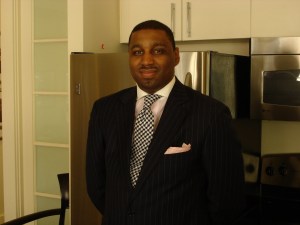
Karim Ferrell
Among other things, we discussed the lack of real guidance for many young men who are looking for role models when it comes to dressing. Too often, magazines and celebrities, “style experts” and self-professed consultants focus on ephemera like of-the-moment trends and “looks” that, frankly don’t look very good. That’s not dressing; it’s dressing up like someone else. Flusser knows from dressing well and the reason he knows is because he lives and breathes menswear but he is not locked in the past.
He as an attitude and persona that is forward looking, intellectually aggressive but not rude. There is the Flusser way to dress and that’s what you need to buy into when you ask Alan and his team for help with your wardrobe. It’s both elegant and casual, formal but witty.
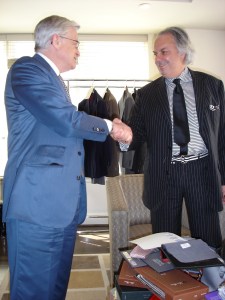
Alan himself was wearing black and white; knowing what colors, patterns and textures work on you the most important thing, he noted. Chalk striped suit, horizontal striped shirt (a Flusser/Gekko signature), solid silk tie, striped grosgrain belt and, almost incongruously, suede driving moccasins sans socks. Natty, personal, assertive but without the “aren’t I clever” attitude. It’s just how he dresses.
Below are some more shots from the afternoon.
What’s Tiger Wearing? It’s In The Script.
 Down in Augusta, Georgia, the Master’s golf tournament just got underway. While it’s one of the world’s leading venues for any golfer, this year it’s all about Tiger Woods.
Down in Augusta, Georgia, the Master’s golf tournament just got underway. While it’s one of the world’s leading venues for any golfer, this year it’s all about Tiger Woods.
I’ll bypass the obvious storyline here because I want to point out something else: what Tiger’s wearing and why. To the surprise of many, Nike, a keystone sponsor that stuck with the embattled golfer, scripts its athlete’s wardrobes.
While the practice of a sponsor dictating athlete’s uniforms is standard in team sports like football, soccer and baseball, golf is a purely individual sport. Sure, apparel brands like Nike, Callaway and Ping all sponsor players, but who knew that for Trevor Immelman Saturday is lyon blue body mapping graphic polo day?
No surprise that Nike has this down to a color coordinating science.
About a week ago, Nike sent me a detailed wardrobe schematic, complete with product SKUs, outlining in detail what each of Nike’s 11 sponsored athletes will be wearing every day of the tourny. There is a certain amount of leeway when it comes to mixing and matching pieces. But for the most part, the golfers are locked in by contract to wear the desired combo – or at least choose only from an approved apparel grouping.

For example, I knew with a high degree of confidence that today Tiger would be wearing a dark grey DRI-Fit open stripe polo (style# 359363-021), black pants and a black hat. As it turns out, he appears to be sporting tomorrow’s white hat and Saturday’s lilac frost textured strip polo (#359361-505).
Well, after all, he is still Tiger.
True Prep Advance Teaser
![]()
Signs of Spring: Preppy Handbook & Lumina Bow Ties
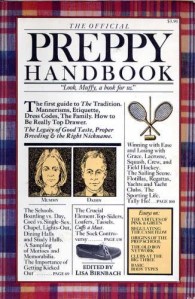 Well, without a doubt a Spring here in the nation’s capitol.
Well, without a doubt a Spring here in the nation’s capitol.
The cherry trees, a gift from the people of Japan to the people of the United States, are blooming across the city and tourists from around the world are flooding in.
Though a little frustrating – please, please stand to the right on escalators – I love seeing how amazed visitors are when walking up to the Capitol or strolling along the White House gates. What I also like, especially after our unusually brutal winter, is that folks are breaking out the Spring wardrobe.
Two items of note on this front; (1) The Preppy Handbook, the tongue-in-cheek arbiter of all things Ivy League, is getting a Part II, and (2) if you like ties, you need to check out a small company from Raleigh, NC, called Lumina.
First, The Book. The New York Times this past Sunday reported – on the front page no less – that Lisa Birnbach is penning a follow-up to the seminal “The Official Preppy Handbook” currently titled “True Prep.” For the pink and green cognoscenti, this is huge; a second coming of sorts.
Though intended to be a parody of the WASPy, gin soaked, boat shoe wearing, blue blazer sporting, East Coast lock-jawed social snobs inhabiting the finest prep schools and ivy covered walls of higher learning, it instead became the bible of how to become one.

Great piece from back in the day (thanks to UnabashedlyPrep.com)
The current wave of preppy resurgence has some serious staying power and is still riding high. And this generation of preps has been pining for its own social guidebook on par with the classic TOPH.
As Scott “The Sartorialist” Schuman mentioned to me once, although Americans like to try on other styles – English country and city looks, Italian sprezzatura, French minimal cool – East Coast prep is ours and ours alone. No one does it better and we should be proud of that.

The other preppy classic: Take Ivy
Outside the U.S., preppy/East Coast/Ivy League/American Trad, call it what you will, is the defining style of America. Japan may be the most obsessed when it comes to getting the precise look down pat, but what makes American preppy so enduring is its imperfection and evolutionary nature.
TOPH made my family cool – and I sure can’t argue with that. So, be on the lookout for more updates on this genuinely exciting news. With any luck, you’ll get to see a sneak peek right here, before it hits the shelves.
Now, on to some preppy wares that you can put to use right now.
Today, I am sporting a bow from the Lumina Clothing Company – a small shop run out of Raleigh, North Carolina. Named after the nearby town of Lumina and founded by a group of tie-loving friends, they make outstanding and unique ties.
As I write this, I am wearing the Something Traditional bow tie (as you can see below). Now, I do like bow ties but don’t often wear them. It takes some guts and I have to be in the right mood – but after tying on this one I think I’ll be in the mood more often. The construction is outstanding, I love the bright, refreshing design and even the hook and roller hardware is impressive. In disclosure, they sent me this tie as no cost; but for $39.00, it’s a darn good deal.

The Something Traditional bow tie
Please take a moment and stop by their site, check out their other bow and neck ties and learn more about this great little company. OTC is always on the lookout for smaller and start-up companies that have a great story and great products – this one has both.
Bruce Boyer on Tailoring
 Recently, we had a vigorous debate on the merits of custom tailoring. Front and center was the very definition of “custom”; did refer only to completely bespoke handcrafting or could one call made-to-measure and its equivalents “custom”?
Recently, we had a vigorous debate on the merits of custom tailoring. Front and center was the very definition of “custom”; did refer only to completely bespoke handcrafting or could one call made-to-measure and its equivalents “custom”?
Jon Green, the noted bespoke clothier and OTC contributor, sent along the following article written by G. Bruce Boyer. As Jon pointed out to me, this argument on the semantics of what is or is not truly custom has been hotly debated for decades and shows no sign of easing.
Quite to the contrary; with one’s ability to hop online and order up a (possibly) custom suit of clothes, sports jacket, shirt or even overcoat, the rift between bespoke purists and everyone else has deepened even more.
So, with thanks to Mr. Green and by extension to Mr. Boyer, let’s see what the preeminent authority on menswear has to say about this thorny issue.

Personal Best
A Slew of Custom Tailoring Choices Adds Up to One Thing: A Suit to Fit Each Individual
By G. Bruce Boyer
Men used to have but one clothing decision: they bought off-the-rack, from a men’s or department store, or had suits custom made by a tailor. Today a panorama of personalized clothing options–bench-made, custom-made, made-to-measure and special order–make the choices wider but a bit confusing.
In an effort to clear things up, let’s define the terminology.
The term bench-made generally indicates that clothes are made in a shop that has the tailor’s name on the door; further, that he is a master tailor (meaning an expert pattern maker, cutter and fitter). The work is done on the premises, an individual pattern is constructed for the exclusive use of each customer, and there is a maximum of handwork.
Most of the same criteria apply to the term custom-made, except that the work is not always done on the premises, and the name above the door is not always that of a master tailor. More often than not, the head of the establishment is someone–such as a designer–whose reputation is based on his taste and who is capable of providing excellent advice.
“Made-to-measure” clothing differs from bench- or custom-made apparel in that tailors use stock patterns that are modified to fit an individual customer. Construction and fabrics of made-to-measure garments may be of very high quality, but, because no individual pattern has to be created, prices can be considerably less.
“Special-order” suits (which we will not cover beyond this point) are made from unaltered stock patterns, but offer a selection of fabrics stocked by the manufacturer and a choice of two or three basic style models. The customer usually pays a premium of 10 percent. The procedure for the customer is much the same whether the construction is bench-made, custom-made, or made-to-measure. All three processes afford measures of personalization and individuality that are otherwise unavailable.
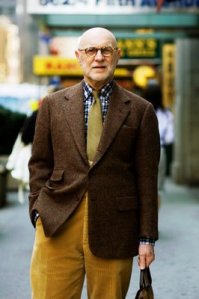
First, styling–which includes general silhouette and specific details–is discussed. The customer will be asked if he favors a built-up look or a more relaxed one. Italian, English or American interpretations are typical options. Of course, the customer’s preferences for fit and feel are also solicited: For example, will the jacket and trousers sit close to the body or have an easier, fuller fit? Does he prefer a higher or lower shoulder? Will the jacket have a soft or firm feel?
The customer chooses the basic form–single- or double-breasted, two-button or three. From there a plethora of details can be ordered. Should the jacket be side, center or unvented? Will the customer prefer flapped, besom, patch or hacking pockets? A ticket pocket perhaps? How many buttons on the sleeve (with working buttonholes, of course)? How many interior pockets? Lapel width or trouser rise may be an issue.
The trousers type must be specified. Will they have pleats or plain front, cuffs or plain bottoms? On-seam or off-seam side pockets, and how many back pockets? A change pocket, a watch pocket? Swelled side seams? Self-supporting waist, belt loops or suspender buttons? Then there is fabric selection. Any reputable shop will have dozens of swatch books from which to choose hundreds and hundreds of cloths–everything from traditional worsteds, flannels and tweeds to the Super woolens (starting with the Super 80s and going up to the 180s), fine silks, cashmeres, cottons, linens and blends. Lightweight fabrics are those considered to be between 7 and 9 1/2 ounces, medium are between 10 and 13 ounces, and anything over 14 is considered heavy in our climate-controlled age. [See Cigar Aficionado, Summer 1995, for a discussion of fabrics.]
Some tailors will have cloths woven exclusively to their own requirements of weight, pattern and color (often their names will be woven into the selvage–the outside strip of the cloth–as proof of exclusivity). Others simply have an eye for that odd bolt of cloth they know their customers will appreciate.
Finally, the tailor will take the measurements. Here’s where the best shine: meticulous measurements make for a suit that fits. Which is why a good tailor will leave nothing to chance. He will want to measure the length of each arm and each leg separately, the chest under and over the arms, the waist above the hips and the seat below them. He will want to measure the shoulders from one side to the other (called “point to point”), and each one from the middle of the back. He will measure the length of the coat that the customer is wearing (only as a rough guide).
The tailor will measure a variety of points on your body that you never thought had anything to do with each other. All these numbers will be recorded in the order book. Your fitter will note, in his own shorthand system, any little problems or idiosyncrasies your body might have: “EP” might stand for erect posture, “LLS” for lower left shoulder. But never mind if your neck is like a corkscrew, your calves protruding, or your back like a dowager’s hump. A good tailor is part psychologist, part cosmetic surgeon. With a little nip and tuck of the cloth here, a bit of extra padding there, some slight narrowing of the trouser leg or widening of lapel, veritable miracles can be performed. (A practical note: it’s a good idea to wear the same sort of shoes and shirt while being fitted as you’ll match with the clothes being made, since this makes measurements more relevant to the way you actually wear your clothes.)
Before departing the shop you will be asked to leave perhaps a 50 percent deposit, and be given an assurance that you’ll be called in several weeks’ time–say three to six–for a fitting. Bench- and custom-made usually require two or three fittings (the first fitting is merely the shell of a garment), while made-to-measure usually requires only one (for minor alterations, button placement and a few minor details).
During the remaining fitting(s) the garment will be fine-tuned, a quarter-inch chalked off in one place, an eighth added in another, a notation made to ease an armhole just a fraction, or minutely tighten the trouser seat. Button stance will be decided. It’s a good idea at this fitting to transfer anything you carry in your pockets to your new clothes, so any adjustments for a bulging wallet or eyeglass case can be made.
The suit should now be properly balanced (each part being where it should be, and sitting correctly) and comfortable. The buttonholes can now be cut and buttons attached. After a final hand-pressing, the suit will be shipped. The record of the measurements (in the form of a paper pattern for bench and custom), tailor’s notes for alterations, and perhaps a small swatch of the selected fabric will be filed away for future orders. Figure on six to 10 weeks from order to delivery.
Personalized clothing is a true investment. Treated with respect and proper maintenance, it will more than pay for itself. A cheap suit looks cheap even when it’s new; a good one looks great even when it’s old.
